ברוכים הבאים ל"העש ואני". #12, וקרנבל הבלוג הראשון שלי. למרות כתיבת בלוג במשך כמה חודשים, עדיין לא הסתכלתי אחורה והרהר איך בדיוק התלהבתי מלפידופטרה מלכתחילה. לזכור זמן או מקום שבו זה קרה הוא בלתי אפשרי, וכמו רבים מעמיתיי ואני בטוח שרבים מהקוראים שלי, הייתה לי רשת פרפרים ו “כלוב חרקים” ביד ברגע שיכולתי ללכת. כשזה מגיע לאנטומולוגיה אני מאמין שכמעט כולם מתאהבים בהתחלה בחרק גדול ובולט. בשבילי זה היה פרפר, באופן טבעי. אני זוכר שבהיתי שעות אינסופיות בגיוון של אורניתופטרה ופפיליו המאוירים בספרו של פול סמארט ספר מפורסם. איפשהו בדרך במרדף אחר משהו חדש התחלתי לשוטט לתוך העולם הלילי. עש מהווים את רוב המגוון של Lepidoptera; בזמן שיש כמעט 11,000 מינים בארצות הברית, רק כמה מאות הם פרפרים. זה פתח במהירות דלת (אולי לתוך תהום…) לשפע המזעזע שנמצא בכל מקום סביבנו. המגוון המדהים הזה משך אותי עכשיו עמוק לתוך הביולוגיה וההיסטוריה האבולוציונית של הלפידופטרה. כשערכתי יחד את ארבע עשרה התרומות האלה של בלוגים של עש, אני פשוט לא יכול שלא להרהר בחזרה על חלק מהמסע שלי..
עאולי אם הייתי ילד באירופה העש הזה (דיילפילה elpenor פורצלוס) היה הראשון לתפוס את עיני. אצל עש עירוני רון לאוטון גילה את המגוון המדהים בחצר האחורית שלו בדיוק כמו שגדלתי כאן בארה"ב. תסתכל על סוגי המלכודות שהוא משתמש בהן, את רובם הוא בנה בעצמו. אחת ההתנהגויות הטובות ביותר של עש היא הנכונות שלהם לצלול אל האור. לא רחוק מדי מרון, מייק ביל כתבה בבלוג גם עשים בריטים. זה יכול להיות די מדהים עד כמה שני החיות שלנו דומות (כמה עשים למעשה הם אותו הדבר).
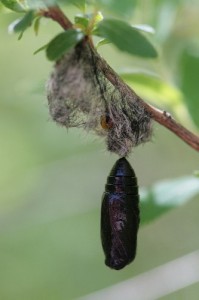 One of the more exciting steps for any moth enthusiast is learning how to rear them from caterpillar. On Seabrooke Leckie’s blog, The Marvelous in Nature, she does just this. ובכן, not from caterpillar, but she discovers a pupae hanging from a twig and brings it home to await the moth. A few days later something appears…but not from the pupae she thought she had! As it turns out she inadvertently collected a second pupae of a microlep successfully hidden amongst the leaves, which is not all too uncommon. As for Seabrooke’s first pupae, it had a different fate – to be parasitized by an Ichneumonidae. As a child I remember rearing caterpillars of Eacles imperialis only to be greeted by swarms of emerging Tachinid flies. Despite being sad over the loss of a stunning moth, our ecosystems would be worse for wear without these parasitoids.
One of the more exciting steps for any moth enthusiast is learning how to rear them from caterpillar. On Seabrooke Leckie’s blog, The Marvelous in Nature, she does just this. ובכן, not from caterpillar, but she discovers a pupae hanging from a twig and brings it home to await the moth. A few days later something appears…but not from the pupae she thought she had! As it turns out she inadvertently collected a second pupae of a microlep successfully hidden amongst the leaves, which is not all too uncommon. As for Seabrooke’s first pupae, it had a different fate – to be parasitized by an Ichneumonidae. As a child I remember rearing caterpillars of Eacles imperialis only to be greeted by swarms of emerging Tachinid flies. Despite being sad over the loss of a stunning moth, our ecosystems would be worse for wear without these parasitoids.
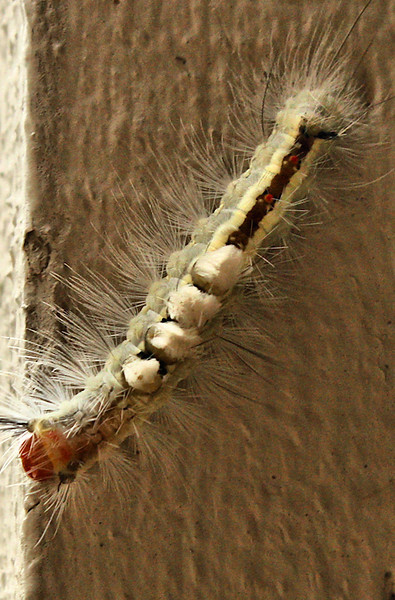 סpeaking of caterpillars and backyards, Katie on הטבע מזהה has found a tiny caterpillar of Lophocampa maculata, a tiger moth formerly known as the family Arctiidae (now it’s a subdivision of the larger Noctuidae). But boring taxonomy aside, they should prove easy to rear on willow. ה adult moth somehow just doesn’t seem as impressive as the caterpillar. The same can be said of this Orgyia leucostigma (זכות) caterpillar as captured by Xenogere, the adult is far less interesting. Aside from both being rather lack-luster adults, the Lymantriidae were also recently submerged back into the family Noctuidae! This is the double edged sword that is taxonomy; just as you become confident with your names, everything gets thrown up in the air and rearranged (not always arbitrarily!)
סpeaking of caterpillars and backyards, Katie on הטבע מזהה has found a tiny caterpillar of Lophocampa maculata, a tiger moth formerly known as the family Arctiidae (now it’s a subdivision of the larger Noctuidae). But boring taxonomy aside, they should prove easy to rear on willow. ה adult moth somehow just doesn’t seem as impressive as the caterpillar. The same can be said of this Orgyia leucostigma (זכות) caterpillar as captured by Xenogere, the adult is far less interesting. Aside from both being rather lack-luster adults, the Lymantriidae were also recently submerged back into the family Noctuidae! This is the double edged sword that is taxonomy; just as you become confident with your names, everything gets thrown up in the air and rearranged (not always arbitrarily!)
 זoving down in scale a bit, yet still strikingly beautiful, is the painted lichen moth – Hypoprepia fucosa. Over in the woods of Missouri Shelly Cox finds this beautiful little moth perched under a leaf. It was moths like these that began my journey downward into the smaller diversity of the Lepidoptera. Such a small moth can be so beautiful, you just have to look a little closer. Most moths, עם זאת, tend to be a little less expressive and look more like this one from NJ in March. Being a little drab however doesn’t make them less interesting, you just have to learn how to appreciate them differently.
זoving down in scale a bit, yet still strikingly beautiful, is the painted lichen moth – Hypoprepia fucosa. Over in the woods of Missouri Shelly Cox finds this beautiful little moth perched under a leaf. It was moths like these that began my journey downward into the smaller diversity of the Lepidoptera. Such a small moth can be so beautiful, you just have to look a little closer. Most moths, עם זאת, tend to be a little less expressive and look more like this one from NJ in March. Being a little drab however doesn’t make them less interesting, you just have to learn how to appreciate them differently.
Over עַל The Nature of Robertson blogger Denis Wilson explores a moth dear to my heart, the Hepilaidae. His backyard moth inspires a creation of art. Yet again, I am jealous of the impressive moths of Australia. Here in the US these moths are so rare that it took me over five years in the field to get my first. תאמין לזה או לא, this group was actually my introduction into the “מייקרו” moths, even if it was on a technicality. Micro by many (just to be confusing) can be used to indicate basal in the evolutionary tree of leps and not literally small…after all some Hepialidae and Cossidae can be monsters!
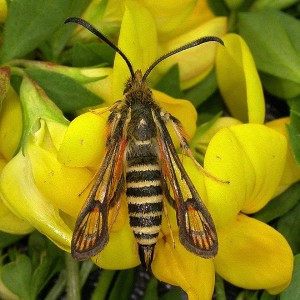 On the other hand, some moths can be pretty common yet difficult to locate, and require a special trick – pheromone lures. Mark Skevington takes his lure out on a warm day in the English countryside to track down some Sesiidae. One of my first jobs in entomology was at the Field Museum was sorting a massive collection of Sesiidae (donated in cigar boxes of course). Moths in this family have a long lifespan as larvae that bore into woody plants or trees. As a diurnal moth you can sometimes encounter them nectaring on flowers, אבל תהיה זהיר, they are brilliant mimics of wasps!
On the other hand, some moths can be pretty common yet difficult to locate, and require a special trick – pheromone lures. Mark Skevington takes his lure out on a warm day in the English countryside to track down some Sesiidae. One of my first jobs in entomology was at the Field Museum was sorting a massive collection of Sesiidae (donated in cigar boxes of course). Moths in this family have a long lifespan as larvae that bore into woody plants or trees. As a diurnal moth you can sometimes encounter them nectaring on flowers, אבל תהיה זהיר, they are brilliant mimics of wasps!
זimicry is common in insects, and wasps are are often favorite model of moths, for good reason. Beetle blogger Ted MacRae over on חיפושיות בבוש can even throw a moth at us once in a while. He also points out some fascinating behavior from a closely related species to the ones he found in Africa “An Australian species, Amata annulata, is known to regularly emit ultrasonic clicks when flying, thought to be aposematic behavior to warn bats of its distastefulness in the same way that that its coloration warns daytime predators”.
 סometimes locating moths isn’t the issue, especially when they hide under your house. ה Biobabbler encountered one of our invasive species while working on her chicken coop, the culprit was Noctua pronuba. Any European moth-er will quickly recognize this gaudy moth, but it is often confused for a קטוקלה species here in the US. Introduced to the Nova Scotia area decades ago it has spread to nearly every state.
סometimes locating moths isn’t the issue, especially when they hide under your house. ה Biobabbler encountered one of our invasive species while working on her chicken coop, the culprit was Noctua pronuba. Any European moth-er will quickly recognize this gaudy moth, but it is often confused for a קטוקלה species here in the US. Introduced to the Nova Scotia area decades ago it has spread to nearly every state.
 צילום is a world unto its own, and capturing the perfect shot can be a hard fought battle. It was only this year that I picked up insect photography, and I’ve much to learn. Over on עש קסם the elusive אnania funerbris proved to be a difficult capture. I can relate to the often fruitless chase in hopes of that perfect shot. This spring I must have spent hours trying to photograph a beautiful purple Schinia…all to no avail. But in the end, the prize is beautiful.
צילום is a world unto its own, and capturing the perfect shot can be a hard fought battle. It was only this year that I picked up insect photography, and I’ve much to learn. Over on עש קסם the elusive אnania funerbris proved to be a difficult capture. I can relate to the often fruitless chase in hopes of that perfect shot. This spring I must have spent hours trying to photograph a beautiful purple Schinia…all to no avail. But in the end, the prize is beautiful.
Next month’s issues of the Moth and Me will be hosted over at Today in NJ Birding History. Don’t forget to submit a posting before July 13, either to Jennifer or Seabrooke! Future dates for TMaM are still open, so don’t all rush to sign up at the same time.
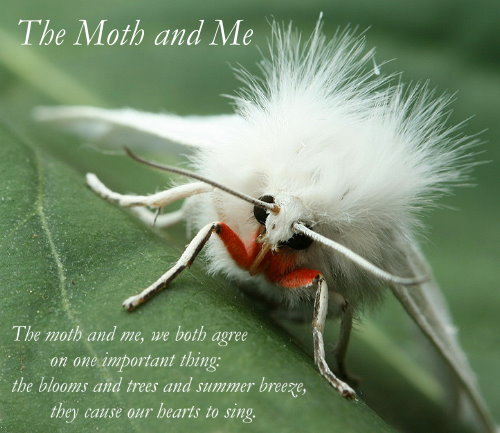


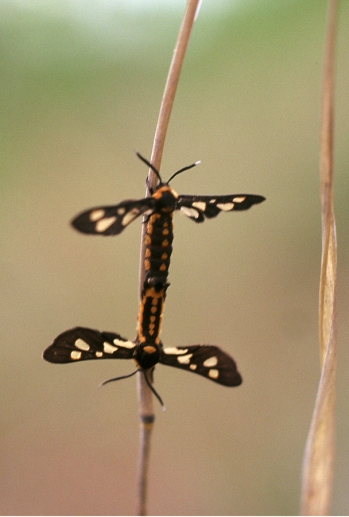

Nice presentation – well organized and pleasing visually. I’ve got my reading to do this weekend. תודה!
היי כריס,
Just a minor observation which I dont want to detract from what I think is a wonderful blog. Deilephila porcellus (Small Elephant Hawk-moth ) is the image you have used, as opposed to Deilephila elpenor – which is the Large Elephant Hawk Moth.
Love the blog 🙂
סטיב.
Whoops, thanks for the correction!
תודה לך, כריס, for including me.
thanks so much for including my post! I haven’t been mothing much lately, but was bitten by the moth bug many years ago. I’m delighted to find your blog and will get a link up on my own right away. Good work on a great installment 🙂
I’ve fallen behind on my Mothy Mondays but hopefully will rectify that in the run-up to the next The Moth and Me carnival. Thanks so much for including my drab little harbinger of spring! I’m looking forward to enjoying all the other entries in this installment of the carnival too.
[…] Grinter at The Skeptical Moth joins the blog carnival host ranks with The Moth and Me #12. Chris is an entomologist at the California Academy of Sciences in San Francisco specializing in […]
[…] latest edition of The Moth and Me, #12, is up over at The Skeptical Moth. Chris has done a great job compiling the varied posts, in the […]
[…] latest edition of The Moth and Me, #12, is up over at The Skeptical Moth. Chris has done a great job compiling the varied posts, in the […]
[…] latest edition of The Moth and Me, #12, is up over at The Skeptical Moth. Chris has done a great job compiling the varied posts, in the […]